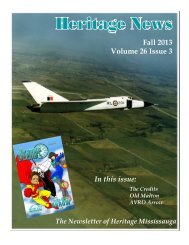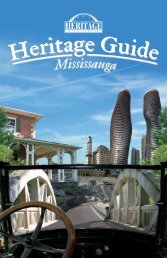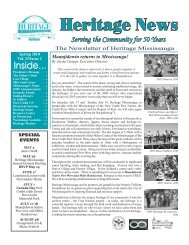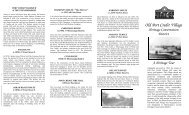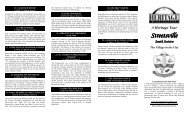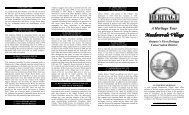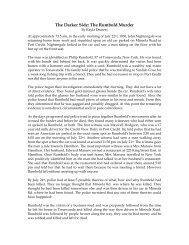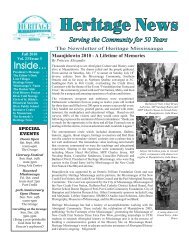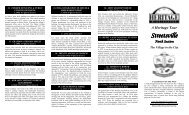final Winter 2010 - Heritage Mississauga
final Winter 2010 - Heritage Mississauga
final Winter 2010 - Heritage Mississauga
Create successful ePaper yourself
Turn your PDF publications into a flip-book with our unique Google optimized e-Paper software.
The Lost Village of Richview<br />
By Nicole Mair<br />
Have you traveled along to the intersection of Highway 401 and<br />
Highway 427, and noticed the small cemetery lodged off to the side<br />
surrounded by on ramps? This isolated pioneer cemetery is one of<br />
the few remnants left today of<br />
the village once known as<br />
Richview.<br />
The village of Richview was a<br />
border village, located partly<br />
in Toronto Township, partly in<br />
Toronto Gore, with some<br />
residents living in York West.<br />
It was officially named<br />
Richview when the village<br />
post office opened February 6,<br />
1852.<br />
The first postmaster was John Davis, who worked from 1852 until<br />
he resigned in 1865. He was followed by Robert M. Burgess, who<br />
was postmaster from 1865 until the year of his death in 1876. Miss<br />
Jennie Burgess, postmistress from 1876 to resignation in 1886,<br />
succeeded Robert Burgess. The post office was moved at that time<br />
from Toronto Township to Etobicoke Township, to the southwest<br />
corner of concession 3, where David Watt took over as postmaster<br />
until 1906. Louis La Rose was the next postmaster from 1906 to<br />
1911. The last postmaster was James Peacock who ran the post<br />
office from March 1911 to July 1911, when it <strong>final</strong>ly closed. Prior<br />
to the post office, mailbags were dropped from passing trains and a<br />
local farmer delivered the mail.<br />
The first Richview School was a log structure built in 1838. It was<br />
located on the west side of Martingrove Road, north of Eglinton<br />
Avenue. The second school was built in 1849 on land donated by<br />
Isaac and Ann Stonehouse. It was located east of Martingrove<br />
Road. The third school was a one-room schoolhouse built in 1874.<br />
It was on the northwest corner of Eglinton Avenue and Martingrove<br />
Road on land donated by Matthew and Janet Canning. The third<br />
school was demolished and replaced in 1915 by a new two-storey<br />
building. It then closed down in 1957. The fifth and <strong>final</strong> Richview<br />
school operated from 1963-1981.<br />
There were two cemeteries in<br />
connection with the village of<br />
Richview. The first one, the<br />
Old Second Line Cemetery<br />
also known as the Stonehouse<br />
Cemetery, is located on the<br />
east side of Martingrove<br />
Road, north of Eglinton<br />
Avenue. The second one, the<br />
Richview Cemetery, is<br />
located on land surrounded by<br />
Highway 27, Highway 401<br />
and Eglinton Avenue.<br />
Richview, 1877 Peel Atlas<br />
Richview Cemetery Plaque, HM<br />
Richview United Church was the first church in the community.<br />
Joseph Stonehouse sold the northwest corner of his farm for the<br />
church to be built on, in 1839. The church trustees for the Richview<br />
United Church were John Chambers, Mark Dawson, Robert<br />
Gracey, John Tuer, William Jolly, Robert Stonehouse, Robert<br />
Stonehouse Jr., James Stonehouse, Joseph Stonehouse and Isaac<br />
Stonehouse. New congregations soon after developed in Richvew.<br />
First, a Union chapel was built by Mark Dawson, Robert Coulter<br />
and William Tuer on land donated by William Knaggs in 1853.<br />
The chapel was located on the southwest corner of Highway 427<br />
and Eglinton Avenue. In 1886, more land was purchased from<br />
Knaggs' farm and a new red brick church was built (on the south<br />
side of Richview Cemetery), it became known as Richview<br />
Methodist Church. At different periods in time the church was part<br />
of the Etobicoke and Malton circuits also included, at varying<br />
times, churches at Burnhamthorpe, Sharon, Bethany, Trinity<br />
(Dixie Road and Elmbank Sideroad) and Thistletown. The Church<br />
offered many activities to local residents throughout the years. In<br />
the early 1920s the Church held oyster suppers, in the 1930s there<br />
were crokinole tournaments and concerts took place at Christmas<br />
time. Sunday school picnics were held at Centre Island in the<br />
1920s, Eldorado Park on the Credit River in the 1930s and later in<br />
Peel Park in Streetsville. The <strong>final</strong> services at Richview Methodist<br />
Church were held on February 13, 1959.<br />
A second congregation met at the<br />
Wesleyan Methodist Chapel, built on<br />
land donated by Robert Stonehouse<br />
around 1853. The congregation was<br />
absorbed into the Union Chapel in<br />
1868, and the building existed until<br />
1880.<br />
Garden parties were held at the<br />
Gracey's, on the Fourth Line, with<br />
entertainment provided by local talent.<br />
Refreshments were also served at the<br />
Gracey's parties including strawberries<br />
and ice cream for dessert. Richview<br />
also had its own Women's Institute,<br />
founded in 1914. The first meeting was<br />
held in Mrs. Ed Stonehouse's home and<br />
the first president was Mrs. Oliver<br />
Dixon.<br />
Richview Methodist<br />
Church, c1920, HM<br />
A popular sporting event in Richview was the ploughing match.<br />
The earliest record of a ploughing match is November 16, 1864 and<br />
it took place on John Davis' farm. Apparently the date coincided<br />
with a heavy snowfall, leaving six inches of snow on the land. The<br />
residents quickly improvised and cleared plots of land for the<br />
ploughmen. Each contestant had a ¼ acre of land and four hours to<br />
complete his work.<br />
There was a community brass band around 1875, which included<br />
members of the Knaggs and Thirkle families. William Knaggs<br />
was a noted violin maker. According to an article, published in<br />
honour of William Knaggs' passing in a 1921 edition of The Globe<br />
and Mail: the Knaggs were “said to be among the oldest violin<br />
makers in Canada. For more than a hundred years some of<br />
Canada's finest fiddles have come from the Knaggs workshop”.<br />
Louis La Rose ran a butcher shop and Christopher Thirkle ran a<br />
blacksmith shop. David Watt took over the blacksmith shop after<br />
1890. James Peacock was the local carpenter. Thomas Whitehouse<br />
kept the tollgate on the plank road that passed through the village.<br />
Some of the main farming families at Richview were Agar,<br />
Bigham, Canning, Coulter, Dawson, Dixon, Gracey, Thirkle,<br />
Middlebrook, Peacock, Pearson and Stonehouse. During the<br />
1920s and 1930s some of the farming families grew tomatoes for<br />
Campbell Soup Company.<br />
Cont’d pg. 15<br />
4 WINTER VOL. 23 / ISSUE 1<br />
HERITAGE NEWS



